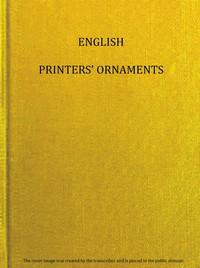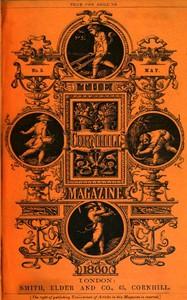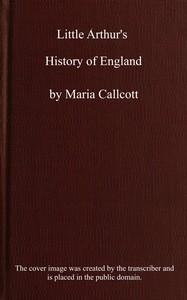|
|
Read this ebook for free! No credit card needed, absolutely nothing to pay.Words: 40549 in 28 pages
This is an ebook sharing website. You can read the uploaded ebooks for free here. No credit cards needed, nothing to pay. If you want to own a digital copy of the ebook, or want to read offline with your favorite ebook-reader, then you can choose to buy and download the ebook.

: English printers' ornaments by Plomer Henry R Henry Robert - Book ornamentation; Printers' ornaments England History; Printers' ornaments England Specimens; Type and type-founding England Specimens@FreeBooksThu 08 Jun, 2023 PREFACE The Gaelic Literature of Ireland is vast in extent and rich in quality. The inedited manuscript materials, if published, would occupy several hundred large volumes. Of this mass only a small portion has as yet been explored by scholars. Nevertheless three saga-cycles stand out from the rest, distinguished for their compass, age and literary worth, those, namely, of the gods, of the demigod Cuchulain, and of Finn son of Cumhall. The Cuchulain cycle, also called the Ulster cycle--from the home of its hero in the North of Ireland--forms the core of this great mass of epic material. It is also known as the cycle of Conchobar, the king round whom the Ulster warriors mustered, and, finally, it has been called the Red Branch Cycle from the name of the banqueting hall at Emain Macha in Ulster. One of these many Cattle-preys was the T?in B? C?alnge, which, there can be little doubt, had behind it no mere myth but some kernel of actual fact. Its historical basis is that a Connacht chieftain and his lady went to war with Ulster about a drove of cattle. The importance of a racial struggle between the north-east province and the remaining four grand provinces of Ireland cannot be ascribed to it. There is, it is true, strong evidence to show that two chief centres, political, if not cultural and national, existed at the time of the T?in in Ireland, Cruachan Ai, near the present Rathcroghan in Connacht, and Emain Macha, the Navan Fort, two miles west of Armagh in Ulster, and it is with the friendly or hostile relations of these two that the Ultonian cycle of tales deals. Ulster, or, more precisely, the eastern portion of the Province, was the scene of all the Cattle-raids, and there is a degree of truth in the couplet,-- "Leinster for breeding, And Ulster for reaving; Munster for reading, And Connacht for thieving." But there are no indications of a racial clash or war of tribes. With the exception of the Oghamic writings inscribed on the pillar-stones by Cuchulain, which seem to require interpretation to the men of Connacht by Ulstermen, the description of the warriors mustered by the Connacht warrior queen and those gathered round King Conchobar of Ulster accord quite closely. The T?in B? C?alnge is one of the most precious monuments of the world's literature, both because of the poetic worth it evidences at an early stage of civilization, and for the light it throws on the life of the people among whom it originated and that of their ancestors centuries earlier. It is not less valuable and curious because it shows us the earlier stages of an epic--an epic in the making--which it does better perhaps than any other work in literature. Ireland had at hand all the materials for a great national epic, a wealth of saga-material replete with interesting episodes, picturesque and dramatic incidents and strongly defined personages, yet she never found her Homer, a gifted poet to embrace her entire literary wealth, to piece the disjointed fragments together, smooth the asperities and hand down to posterity the finished epic of the Celtic world, superior, perhaps, to the Iliad or the Odyssey. What has come down to us is "a sort of patchwork epic," as Prescott called the Ballads of the Cid, a popular epopee in all its native roughness, wild phantasy and extravagance of deed and description as it developed during successive generations. It resembles the frame of some huge ship left unfinished by the builders on the beach and covered with shells and drift from the sea of Celtic tradition. From the historical standpoint, however, and as a picture of the old barbaric Celtic culture, and as a pure expression of elemental passion, it is of more importance to have the genuine tradition as it developed amongst the people, unvarnished by poetic art and uninfluenced by the example of older and alien societies. According to the Chronicles of Ireland, as formulated in the Annals of Tigernach, who died in 1088, King Conchobar of Ulster began to reign in the year 30 B.C., and he is said to have died of grief at the news that Christ had been crucified. His reign therefore lasted about sixty years. Cuchulain died in the year 39 A.D. in the twenty-seventh year of his age, as we learn from the following entry: "The death of Cuchulain, the bravest hero of the Irish, by Lugaid son of Three Hounds, king of Munster, and by Erc, king of Tara, son of Carbre Niafer, and by the three sons of Calatin of Connacht. Seven years was his age when he assumed arms, seventeen was his age when he followed the Driving of the Kine of Cualnge, but twenty-seven years was his age when he died." These apparent synchronisms, of course, may only rest upon the imagination of the Christian annalists of Ireland, who hoped to exalt their ancient rulers and heroes by bringing them into relation with and even making them participate in the events of the life of the Saviour. But in placing the date of the expedition of the T?in at about the beginning of the Christian era, Irish tradition is undoubtedly correct, as appears from the character of the civilization depicted in the Ulster tales, which corresponds in a remarkable degree with what authors of antiquity have recorded of the Celts and with the character of the age which archaeologists call "la T?ne," or "Late Celtic," which terminates at the beginning of the first century of our era. Oral tradition was perhaps occupied for five hundred years working over and developing the story of the T?in, and by the close of the fifth century the saga to which it belonged was substantially the one we have now. The text of the tale must have been completed by the first half of the seventh century, and, as we shall see, its oldest extant version, the Book of the Dun, dates from about the year 1100. But, whatever may be the precise dates of these events, which we are not in a position to determine more accurately, the composition of the T?in B? C?alnge antedates by a considerable margin the epic tales of the Anglo-Saxons, the Scandinavians, the Franks and the Germans. It is the oldest epic tale of western Europe, and it and the cycle of tales to which it belongs form "the oldest existing literature of any of the peoples to the north of the Alps." The deeds it recounts belong to the heroic age of Ireland three hundred years before the introduction of Christianity into the island, and its spirit never ceased to remain markedly pagan. The mythology that permeates it is one of the most primitive manifestations of the personification of the natural forces which the Celts worshipped. Its historical background, social organization, chivalry, mood and thought and its heroic ideal are to a large extent, and with perhaps some pre-Aryan survivals, not only those of the insular Celts of two thousand years ago, but also of the important and wide-spread Celtic race with whom Caesar fought and who in an earlier period had sacked Rome and made themselves feared even in Greece and Asia Minor. The following is the Argument of the T?in B? C?alnge, which, for the sake of convenience, is here divided into sections: One night at the palace of Cruachan in Connacht, a dispute arose between Queen Medb, the sometime wife of Conchobar, king of Ulster, and her consort Ailill, as to the amount of their respective possessions. It may be remarked in passing that in those days in Ireland, married women retained their private fortune independent of their husbands, as well as the dowry secured to them in marriage. To procure the evidence of their wealth, the royal pair sent messengers to assemble all their chattels which, on comparison, were found to be equal, excepting only that among Ailill's kine was a lordly bull called Finnbennach, "the Whitehorned," whose match was not to be found in the herds of the queen. As we might expect, Medb was chagrined at the discovery. Now her herald macRoth had told her that Dar? macFiachna, a landowner of Cualnge, a district in the territory of her former husband, possessed an even more wonderful bull than Ailill's, called Donn Cualnge, "the Brown Bull of Cualnge." So she despatched macRoth to Dar? to pray for the loan of the bull. Dar? received the queen's messengers hospitably and readily granted her request, but in the course of the entertainment, one of the messengers, deep in his cups, spoke against Dar?, and he, hearing this, withdrew his promise and swore that he would never hand over the Brown Bull of Cualnge. Free books android app tbrJar TBR JAR Read Free books online gutenberg More posts by @FreeBooks
: The Cornhill Magazine (Vol. I No. 6 June 1860) by Various - England Periodicals; Short stories English Periodicals; English literature Periodicals@FreeBooksThu 08 Jun, 2023

: The Cornhill Magazine (Vol. I No. 5 May 1860) by Various - England Periodicals; Short stories English Periodicals; English literature Periodicals@FreeBooksThu 08 Jun, 2023
|
Terms of Use Stock Market News! © gutenberg.org.in2025 All Rights reserved.






